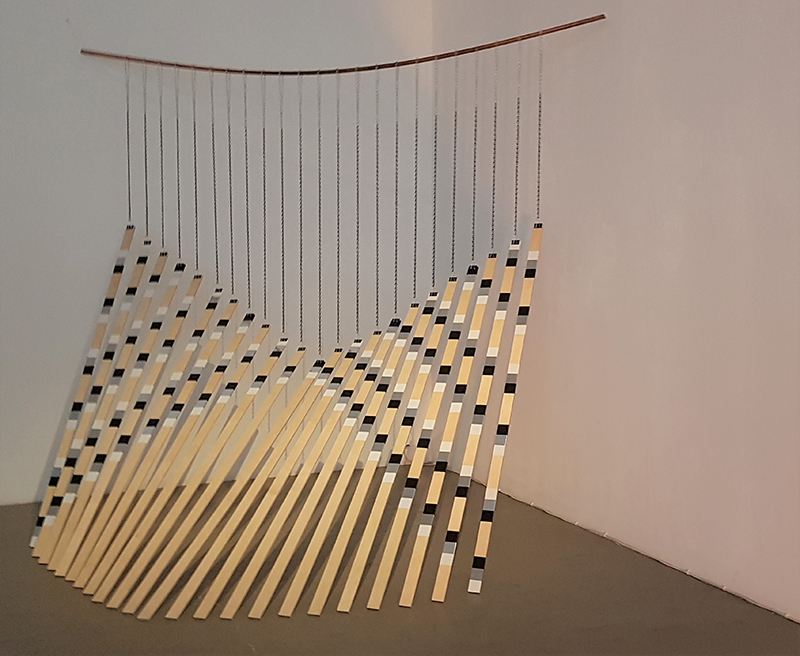By Jane Pickersgill – Gardner, Final year student
on the MFA Fine Art course at Wimbledon College of Arts

Image: Hanz Hancock and Patrick Morrissey
Expanding Systems at APT (Art in Perpetuity Trust) Gallery, SE8 4SA – until 18th February 2018
Expanding Systems is the third ‘artist’s shot’ in which a member of APT’s artistic community curates an annual exhibition at the gallery.
Chief curator for 2018 is Wimbledon alumni Brigitte Parusel, working with Hans Hancock and Patrick Morrissey , who founded Saturation Point, an ‘online editorial and curatorial project’ with several other alumni as contributors.
In Expanding Systems Brigitte asks whether ‘creative coding can become a new medium for contemporary artists’ and whether ‘painting and sculpture can influence the practice of artists who use creative coding? Her interest in coding and in the practices of artists whose work uses repetitious methods, or a systems-based approach, stems from personal experience of coding.
Aside from being a printmaker (in which medium she is currently focussed on patterns of intersecting circles), she uses a variety of materials for large sculptural constructions which might include digital projections. The show is split into two parts, between two rooms.

Image: Charley Peters and Goia Mujalli
‘Analogue’ works included in the show are by Charley Peters, Fiona Grady (both showing paintings) and installation work from Michael Iveson, Goia Mujalli, Hans Hancock and Patrick Morrissey.
‘Digital’ artists include Casey Reas, Tim Rodenbroeker and several students on the MA Computational Arts at Goldsmiths who are showing two projects in the gallery. One comprises works printed in 2D format, and the second features projection mapping. If you know nothing about computer generated art have no fear. The show includes a short film Algorithmic Signs; about the pioneers of this genre, made by Dr Francesco Franco, an art historian researching the subject. The interviewees include Manfred Mohr and Vera Molnar (still practicing today at the age of 94).

Image: Fiona Grady and Goia Mujalli
I visited the exhibition on the penultimate weekend which featured a walk and talk around the exhibition with the curator and several of the participating artists. Brigitte introduced the thinking behind the exhibition and work by artists not present. She exhorts artists to view the screen as a ‘gateway to limitless space’ and feels that we (artists) might want to think of coding as a ‘new tool available to us’.

Image: Casey Reas
One wall of the gallery is devoted to an astounding Casey Reas work running in real time; an abstract geometric composition generated by data. Hypnotic lines and dots undulate and drop off the field of composition as you watch. His work can be seen on the Creators Project and he is best known for the coding platform Processing, developed with Ben Fry. Processing is a programming environment for learning how to code within the context of visual arts.
https://creators.vice.com/en_uk/topic/generative-art
Other digital works in the show include an audio-visual piece by Tim Rodenbroeker. The visuals are generated by musical data: specifically, the work of J.S. Bach – the output is a mesmerising geometric monochromatic code, sliding and flashing repetitively across a screen.

Image: Student work – Project Mapping
‘Analogue’ work, though no less interesting for it, includes paintings by Charley Peters and Fiona Grady (both Wimbledon alumni). Interestingly they both talked about the imperfections in their artwork which, tellingly, are only visible in the gallery, not when viewing it online, on a screen. Both artists felt these to be perfectly acceptable, even adding more layers of meaning to the works. Fiona mentioned that she felt it important to show the ‘hand of the artist’ and Charley pointing to the chance of materials not responding in a way which is always controllable.
Curiously, Charley’s comment echoed a description of processing by student Gaytri Geeta Roopnarine; about having no control over the output once the code was written. Her role was then changed to that of curator; to use her artist’s eye to watch the visuals evolve. Ultimately, she then had to decide at what point to stop the process and/or select a chosen image from the onscreen information.
Interestingly, the subject of digital, factory made perfection was also dealt with by Michael Iveson’s sculpture which bridged the analogue/digital divide and sat centrally in the digital room of the exhibition. His installation aimed to reveal the disruptions in mass-produced material (bubble wrap) – with flaws in the pattern of the surface visible only once paint is applied.
I recommend a visit during the final four days; 15th-18th inclusive. Opening hours are 12-5pm and you may be lucky to chat to Brigitte herself though her work is not in this show.
For more information contact:
@APTGallery on Twitter & Instagram,
A.P.T. Art in Perpetuity Trust, Harold Wharf, 6 Creekside London SE8 4SA
About the author:
Jane Pickersgill – Gardner is a final year student on the MFA course at Wimbledon College of Art.
“My work investigates our expanding cities, landscapes constantly being re-made, in flux, sold to us as aspirational destinations and dwelling places. I am especially interested in the anonymous, corporate non-spaces which are the in-between spaces we pass through daily, scarcely noticing their characteristics and features. They are haunted by the architectural concept of the city as a ‘machine to live in’. My current research uses structurally banal and ubiquitous materials to suggest a ‘ghost’ of these super-modern global landscapes which we increasingly inhabit”.
@tatteredstones on Twitter & Instagram

